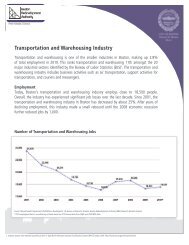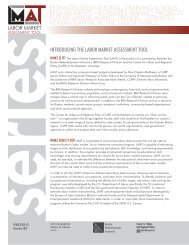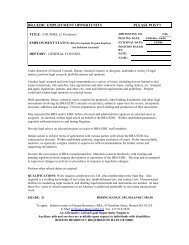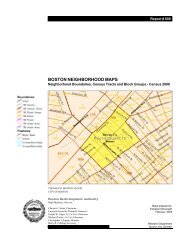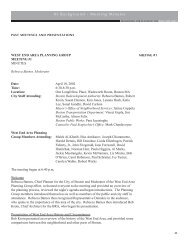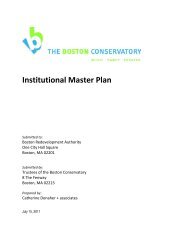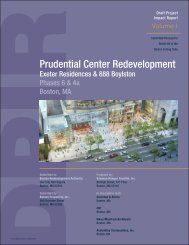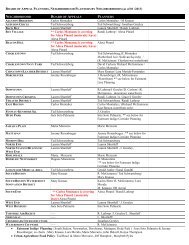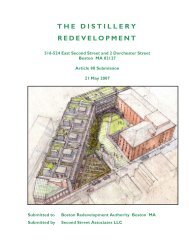point cover jan 13 - Boston Redevelopment Authority
point cover jan 13 - Boston Redevelopment Authority
point cover jan 13 - Boston Redevelopment Authority
You also want an ePaper? Increase the reach of your titles
YUMPU automatically turns print PDFs into web optimized ePapers that Google loves.
Summary of Key Findings<br />
\\MABOS\projects\1<strong>13</strong>81.00\reports\Article80\<br />
Expanded_PNF\04_Environmental_FINAL.do<br />
c<br />
Vanasse Hangen Brustlin, Inc.<br />
The Point, <strong>Boston</strong><br />
The Project will not result in solar glare impacts on streets (visual impairment vehicle traffic), or on public<br />
open spaces and pedestrian areas (discomfort due to reflective spot glare). The Project will not produce solar<br />
heat buildup on nearby buildings that may receive reflective sunlight from the proposed building. The<br />
proposed building design specifications, such as façade design, glazing systems with specific solar and<br />
optical characteristics as well as streetscape improvements (i.e., street trees) are considered to mitigate the<br />
reflected glare from the viewers’ viewing directions. Additionally, the proposed building design aims to<br />
minimize any negative solar glare effects on passing birds by creating a façade composed of a series of angled<br />
elements that alternate between masonry and glazed panels, thus disconnecting visual reflections.<br />
<br />
Solar Glare Analysis Methodology<br />
Glare is the loss in visual performance or visibility, or annoyance or discomfort produced by a luminance in<br />
the visual field greater than the luminance to which the eyes are adapted. There are three types of glare:<br />
veiling or disability glare, discomfort glare, and reflection glare.<br />
A computer simulation combined with spread sheet calculations are used to determine the CIE Glare Index<br />
(CGI) and/or CIE Glare factors/ rating for a given site. The simulation uses hourly weather data based on<br />
average <strong>Boston</strong> climatic conditions to obtain glare conditions within the critical field of view. The computer<br />
simulation also accounts for actual glass/glazing assumptions in order to determine spectral transmittance<br />
and reflectance data which identifies problem areas near the proposed building.<br />
The subjective scales for the evaluation of these reflections include:<br />
Perceptible - The <strong>point</strong> at which you would prefer the light not to be present. Imagine that it is a pilot<br />
light on a computer and you are obliged to set the pilot light on/pilot light off. This is the level at which<br />
you would begin to care about such decision.<br />
Annoying - You could live with this glare source present if you were borrowing someone else's computer<br />
for a day. If this glare source were present, you would prefer to remove the glare source if it were<br />
possible, but could live with this annoyance for the next hour or so.<br />
Disturbing - This make you feel uncomfortable. If you had to work like this for any reasonable length of<br />
time (5 minutes or so) you would do something to <strong>cover</strong> the source. Shield your eyes, etc. In order to<br />
avoid the discomfort.<br />
Intolerable - you could not imagine yourself working with the light source like this. You would certainly<br />
close your eyes or take another avoidance action.<br />
<br />
Solar Glare Impact Analysis Findings<br />
The proposed building design specifications, such as façade design, glazing systems with specific solar and<br />
optical characteristics as well as streetscape improvements (i.e., street trees) are considered to mitigate the<br />
4-<strong>13</strong> Environmental Protection



